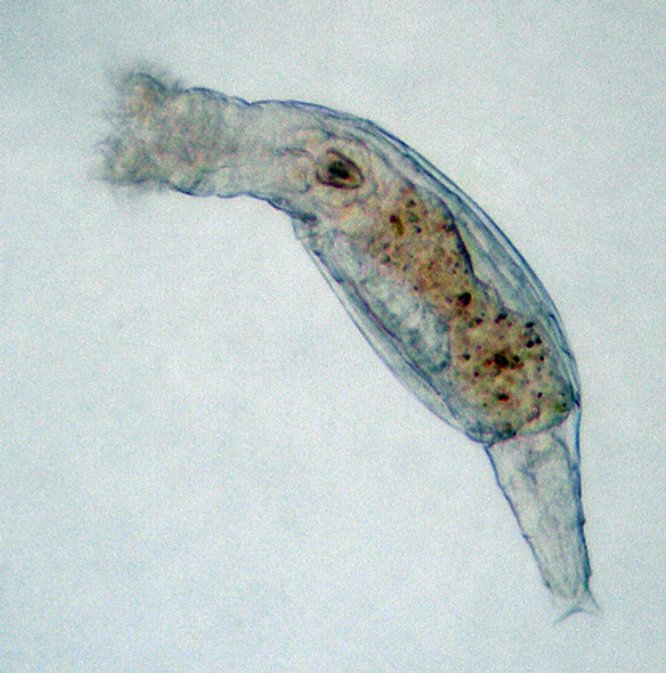Bdelloid rotifers have been veiled in mystery for decades. Despite extensive studies of this class of tiny freshwater invertebrates, no one has observed any trace of sex: no proven males, hermaphrodites, mating, or meiosis. Unlike other asexual organisms, which tend to be short-lived in evolutionary history, the apparently asexual bdelloid rotifers have managed to persist for millions of years and have diverged into hundreds of species. Such persistence without sexual reproduction challenges the view that sex is essential for the long-term evolutionary success of eukaryotes. Do these populations somehow avoid the accumulation of detrimental mutations thought to occur with asexual reproduction, or have we simply been investigating them under the wrong conditions?
A study by Signorovitch et al. published in the June issue of GENETICS sought to answer this question by using a method of population genetics that allowed the investigators to look for evidence of infrequent or atypical sex in bdelloid genomes.
By comparing genome sequences of individuals descended from a common ancestor, researchers are able to find clues to the population’s mode of reproduction. For any two individuals in an asexual population, the phylogenetic distance between a sequence in one individual and its homolog in the other should be the same for all such sequence pairs. That is because all the sequences in these individuals have been evolving independently of each other for the same number of generations. But if genetic material has been transferred between individuals in the population (as in sexual reproduction), two individuals may be closely related at one sequence, but more distantly related at its homolog. Signorovitch et al. searched for evidence of this phylogenetic pattern—called allele sharing— in the genomes of a species of bdelloid collected from geographically diverse sites.
The results clearly demonstrate that three of six individuals sampled from a mitochondrial clade show allele sharing consistent with sexual reproduction. At each of four genomic regions, a particular individual shared one of its alleles with a second individual and shared its other allele with a third individual. This suggests that genetic material was transferred between individuals via a cross.

Study species, Macrotrachela quadricornifera, and its eggs at right. Provided by Dr. Matthew Meselson
Finding three closely-related individuals in a small sample of geographically well-separated bdelloids suggests that lines that have experienced recent crossing have a fitness advantage over lines that have not, leading to the predominance of the prior. In support of this possibility, Signorovitch et al. cite a study indicating that the loss of sex in the water flea Daphnia pulex (which cycles between asexual and sexual reproduction) is followed by surprisingly rapid extinction. This is thought to be due to the effects of gene conversion, which allows the expression of accumulated recessive deleterious mutations. If bdelloids are also cyclically sexual, Signorovitch et al. propose, then descendents from recent outcrossing that restores heterozygosity would have enhanced fitness and become predominant in the sampled clade.
The evidence for sexual reproduction seems incompatible with previous work that concluded these organisms lack the homologous chromosome pairs needed for standard meiosis, a necessary process for sexual reproduction. The authors hypothesize that bdelloids may undergo a rare type of meiosis that can function without homologous chromosomes. Observed in plants of the Oenothera genus, this involves parental genomes segregating without assortment or crossing over. In other words, segregation is achieved without side-by-side chromosome pairing and without assortment or crossing over, enabling chromosomes of the same parentage to stay together generation after generation.
Signorovitch et al. discovered that a population previously thought to evolve without sex does in fact experience a unique form of sexual exchange. While these organisms remain enigmatic, the authors provide a glimpse into how bdelloid rotifers may have persisted through time.
CITATIONS:
Signorovitch, A., J. Hur, E. Gladyshev & M. Meselson (2015). Allele Sharing and Evidence for Sexuality in a Mitochondrial Clade of Bdelloid Rotifers, Genetics, 200(2), 581-590. doi: http://dx.doi.org/10.1534/genetics.115.176719 http://www.genetics.org/content/200/2/581.full
Tucker, A. E., M. S. Ackerman, B. D. Eads, S. Xu, and M. Lynch (2013) Population-genomic insights into the evolutionary origin and fate of obligately asexual Daphnia pulex. Proc. Natl. Acad. Sci. USA 110: 15740–15745 http://dx.doi.org/10.1073/pnas.1313388110
Umen, J. G (2015) Lost and Found: The Secret Sex Lives of Bdelloid Rotifers, Genetics, 200(2), 409-412, doi: http://dx.doi.org/10.1534/genetics.115.176388 http://www.genetics.org/content/200/2/409.short?rss=1































